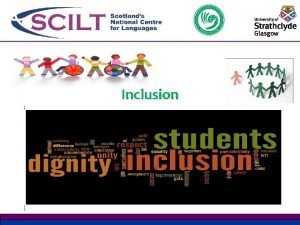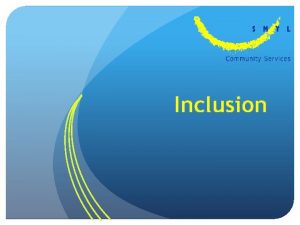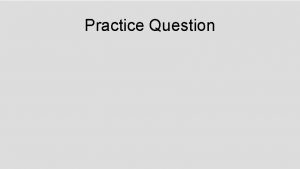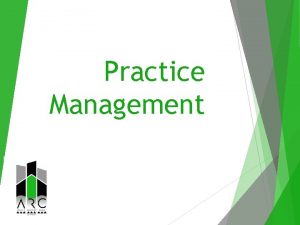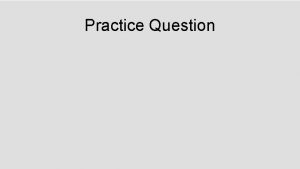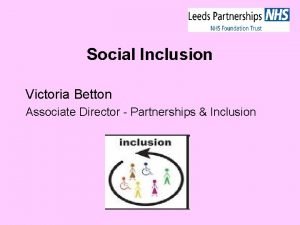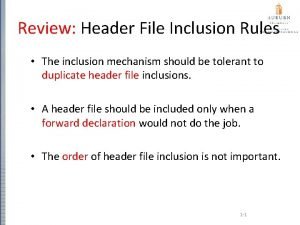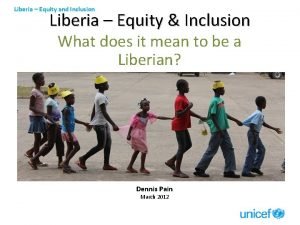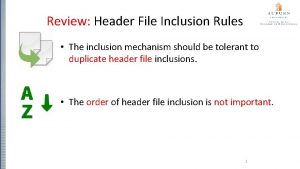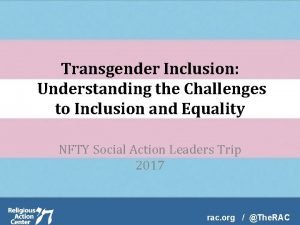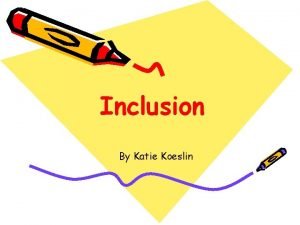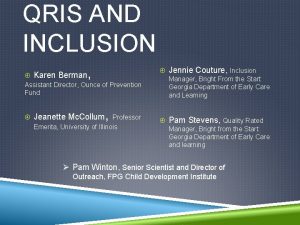INCLUSION INCLUSION What is inclusion The practice of






















- Slides: 22

INCLUSION

INCLUSION What is inclusion? The practice of educating all children in the same classroom, including children with physical, mental, and developmental disabilities. Under an inclusion model students with special needs spend most or all of their time with nondisabled students.

INCLUSION A belief that all children are included for all or part of the day in the general education setting with their needs being met will be treated equally are in classrooms or environments designed for success will improve academic, behavior, and social skills with appropriate supports

INCLUSION Goals on inclusion: Better Instruction More time on task Fewer interruptions Closer monitoring Higher self-esteem Sense of belonging Teacher teamwork

INCLUSION Depending on the student, . . . Depending on the IEP, . . . Depending on the level of supports, . . . Depending on the disability, . . . Depending on the subject area, . . .

INCLUSION Key concepts of LRE Must be individually determined and based on student’s individual needs Applies to all children with disabilities Starts with the assumption that students will be in the general education classroom Consideration and use of supplementary aids and services to make the general education class a first and viable option is required

INCLUSION What does the law say? Right for FAPE – Free Appropriate Public Education with appropriate supports and services regardless of disability in the Least Restrictive Environment (LRE) LRE -Means that to the maximum extent possible, each child with a disability must be educated with children who are not disabled unless the nature and severity of the disability is such that the education in the general environment with the use of supplementary aids and services can not be achieved satisfactorily All students must have access to the general education curriculum – to the maximum extent possible. Right of all children to a continuum of services to meet their individual needs.

INCLUSION Inclusive classroom should: Be supportive and caring in which every student feels accepted Provide opportunities for students with special needs to be educated with same age peers

INCLUSION Students with special needs that are serviced in the general education classroom will have an IEP. The IEP will contain the following: learning goals and objectives for the coming year the services and supports the student will receive accommodations for the student (different ways of learning or responding) if and to what extent the general curriculum will be modified for the student

INCLUSION Materials / Equipment that might be needed in a inclusion classroom: Calculators Computers Graphic organizers Books on tapes Tape recorders Software programs Videos on lessons

INCLUSION Inclusion classroom strategies Provide student’s a course outline Have a routine throughout the school year Refrain from asking student’s to read to the class if they have a reading disability Provide review guides for all exams Provide students with class notes

INCLUSION Responsibilities of staff members that provide inclusion support: Be familiar with student’s IEP Be familiar with student’s accommodations / modifications Be familiar with student’s learning styles Plan curriculum Deliver instruction Assess students progress Evaluate students Develop instructional strategies

INCLUSION Benefits of inclusion for students with special needs include: Greater access to the general curriculum Additional assistance from special education personnel A variety of teaching approaches Provide opportunities for students with special needs to be educated with same age peers Integration Help the student’s self esteem Give students with a special needs a sense of belonging Ability to promote development and learning so that all students may reach their potential. Students are given an opportunity to learn from one another Students with disabilities are experiencing academic challenges

INCLUSION Benefits of inclusion for students without disabilities include: Meaningful friendships Increased appreciation of individual differences Respect for all people Preparation for an adult life in an inclusive society Opportunities to master activities by practicing and teaching others Greater academic outcomes

INCLUSION What are some of the barriers to effective inclusion practices? Funding General education classrooms might not be the best setting and students might exhibit behavior problems Low expectations from teachers for students with disabilities

INCLUSION Requirements that must be met in order for inclusion to work at the campus: Professional staff development Collaboration between parents, teachers, and administrators Time for teachers to plan, meet, create, and evaluate the students together Students with inclusion support should be clustered in specific classes but distributed across all teachers Sufficient funding so that schools will be able to develop programs for students based on student need Provide additional resources for students and staff

INCLUSION MODELS Full Inclusion- places a special education teacher as a full partner in a classroom with a general education teacher The general education teacher is the teacher of record and is responsible for the child

CO-TEACHING MODELS Co-teaching is one possible strategy to support students with disabilities in a general education setting. Two teachers are in the classroom General Education- is an expert in the curriculum Special Education- assist with modifications and accommodations to help students access the curriculum.

CO-TEACHING MODELS Parallel Teaching-two teachers teaching the same content simultaneously in one classroom. Station Teaching- teachers split the content into different stations around the classroom. Alternative Teaching- one teacher works with the majority of students in a full class setting, and the second teacher pulls a small group of students out of the classroom (or to an area of the classroom) to work together in a small group. One Teaches, One Assists-one teacher teaches the lesson, the other teacher walks around the room answering student questions, keeping students on task and helping individual students when needed.

INCLUSION Staff development is essential Workshops Conferences Collaboration with experience staff Internet Online Trainings

INCLUSION "Inclusion works when teachers believe that all children can learn. " Dayle Timmons “Inclusion is changing the rules of the game so that everyone can play and everyone can win. ”

QUESTIONS
 Các châu lục và đại dương trên thế giới
Các châu lục và đại dương trên thế giới Phản ứng thế ankan
Phản ứng thế ankan ưu thế lai là gì
ưu thế lai là gì Môn thể thao bắt đầu bằng chữ đua
Môn thể thao bắt đầu bằng chữ đua Thẻ vin
Thẻ vin Hình ảnh bộ gõ cơ thể búng tay
Hình ảnh bộ gõ cơ thể búng tay Cái miệng bé xinh thế chỉ nói điều hay thôi
Cái miệng bé xinh thế chỉ nói điều hay thôi Từ ngữ thể hiện lòng nhân hậu
Từ ngữ thể hiện lòng nhân hậu Trời xanh đây là của chúng ta thể thơ
Trời xanh đây là của chúng ta thể thơ Tư thế ngồi viết
Tư thế ngồi viết Ví dụ giọng cùng tên
Ví dụ giọng cùng tên Voi kéo gỗ như thế nào
Voi kéo gỗ như thế nào Thơ thất ngôn tứ tuyệt đường luật
Thơ thất ngôn tứ tuyệt đường luật Hổ sinh sản vào mùa nào
Hổ sinh sản vào mùa nào Thế nào là hệ số cao nhất
Thế nào là hệ số cao nhất Diễn thế sinh thái là
Diễn thế sinh thái là đại từ thay thế
đại từ thay thế Frameset trong html5
Frameset trong html5 Vẽ hình chiếu vuông góc của vật thể sau
Vẽ hình chiếu vuông góc của vật thể sau Thế nào là mạng điện lắp đặt kiểu nổi
Thế nào là mạng điện lắp đặt kiểu nổi Mật thư anh em như thể tay chân
Mật thư anh em như thể tay chân Lời thề hippocrates
Lời thề hippocrates Vẽ hình chiếu đứng bằng cạnh của vật thể
Vẽ hình chiếu đứng bằng cạnh của vật thể
























